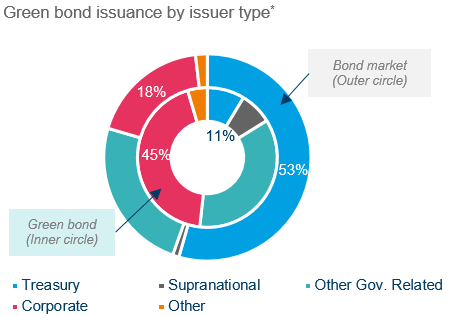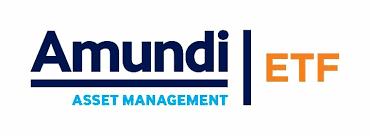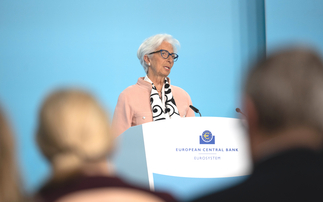
Achieving net zero means dramatically reducing global greenhouse emissions and compensating for any residual emissions by reabsorbing the same amount from the atmosphere. It requires a major shift in how investors allocate capital, and how they engage with companies to turn well-meaning ideas into action.
Here we explore one option that investors have to start their own climate transition. This involves mobilising some of the $127trn accumulated in the global bond market[1].
We're talking about ‘green bonds', a relatively small but booming segment of the bond market. Green bonds offer investors a way to direct some of their capital towards climate projects. As we'll see, the rationale for including them in portfolios is stronger than ever.
First things first: how do they work?
[1]. Source : SIFMA, Capital Markets Factbook 2022, data as of 31 December 2021
Investing with purpose
When you buy a normal or ‘vanilla' bond, you're lending your money to the issuing company or government with no strings attached. The issuer uses the proceeds for an unspecified purpose, and pays a coupon on the bond in return. Eventually—in most cases—you get your principal (loan) back.
Green bonds, in contrast, raise money for a specified purpose. For a bond to be certified as green, its proceeds must help fund climate or environmental projects. So, unlike with a vanilla bond, you will always know where your money is going. You can think of it as financing with ‘green strings attached'.
A green bond could be financing a new windfarm, or a project to increase a low-lying town's flood resilience, or a train station refurbishment which boosts public transport use - any of a wealth of projects that will go on to benefit the environment in a specific, tangible way.
Put simply, green bonds offer much more transparency and measurability than normal bonds. Yet they still fly under the radar for many investors. Many, that is, but not all. Away from the mainstream, the green bond market has been booming in popularity.
For investors, there are several things worth knowing about this growing segment of the market.
Why green bonds are going mainstream
Speak to any climate activist and you'll hear the fight against climate change is slow - too slow. One reason why is because climate projects need to be financed, and there hasn't been a good mechanism for connecting investor cash with the green projects that need it most.
Let's consider for a moment what climate-action or mitigation projects involve. This could be capital expenditure for new infrastructure, or major changes to existing systems, or investment in developing technologies. It all costs money, and sometimes that money is hard to find.
Green bonds open up a channel to deliver much-needed funding directly to green projects.
But it's not an act of charity - these are investments, and so they come with a return. Just like their vanilla counterparts, green bonds pay a coupon. After all, a windfarm will generate and sell electricity. A new transport hub will process thousands of paying passengers. Flood resilience is worth paying for today if it reduces future costs. Investing in the energy transition is still investing.
That's why, even putting environmental concerns aside, green bonds can be an attractive investment. They offer returns and diversify portfolio risk while contributing to climate action in a measurable way. And they are being rapidly snapped up by investors waking up to the fact that environmental benefits don't have to come at a premium.
Investors are waking up to the potential
Green bonds are still a small part of the giant global bond market, but they're on a very strong growth trajectory. Since the inception of the green bond market in 2007, global cumulative issuance has reached $2.3 trillion[2].
Of note is the issuer mix for green bonds (the proportion of green bond issuers that are corporate, sovereign, local government, etc.) which is very different from the overall bond market. Just 11% of total issuance is from sovereign issuers - national governments - versus 53% in the global bond market. The reverse is true for corporate issuance: 45% of green bonds are issued by corporations, versus 18% in the global bond market.
[2] Source : https://www.climatebonds.net/

Source: Bloomberg, Amundi as of 31/03/2023. *BClass classification. Green Bond as defined by Bloomberg. Past performance is not a reliable indicator of future performance.
We believe sovereign green bond issuance will rise further, bringing the issuer mix closer to what we see in the global bond market and increasing the size and diversity of the bonds on offer to investors.
Sovereign green bonds are increasingly used help to fund government investments in projects with environmental objectives (mostly climate change mitigation). In 2022, clean transport was the main beneficiary (almost 50%) of investment from green bond issuance by euro area governments, followed by energy efficiency (including green construction) and renewable energy which together represent a third of allocations. Progress has also been made in strengthening green capital markets with the European Green Bond Standard designed that aims to increase and expand the environmental ambitions of the green bond market.
With energy independence and security rapidly climbing the governmental agenda, even more may decide to issue green bonds to finance the transition, rather than rely on external fuel sources or less direct funding. That could create an interesting evolution of the market and offer new opportunities for fixed income investors.
Positive investing with a green bond ETF
Green bonds are a way for investors to get more certainty about the effect they make. With "use of proceeds" rules and impact reporting, they can be sure they're funding green projects.
It means green bonds are both a powerful and positive investment. For all the alarming statistics on global warming, humanity still has a big opportunity to limit climate change before it's too late. Scientific research has determined +1.5°C as the point after which there would be a catastrophic impact on the environment, our societies and life on earth. There's a phenomenal amount of investor cash that could be mobilised to help keep warming at or below 1.5°C.
Green bonds provide a route forward to shift those trillions into projects where they will make the most difference.
Of course, for most people it's not practical to buy and sell individual green bonds. Fortunately, specialist green bond ETFs offer an efficient alternative, bringing together labelled green bonds and providing them for investment in a simple ETF wrapper. Our Green Bond ETF is the original, and still by far the largest with €613 million under management.[2].
We measure and report on its allocation of proceeds. In 2022, the top three sectors to receive proceeds from this ETF were Energy (41%), Green Buildings (28%) and Clean Transport (14%)[3].
Please note: The approach implemented by the Lyxor Green Bond (DR) UCITS ETF by investing in green bonds is largely based on third party data that may be incomplete, inaccurate or unavailable from time to time, and which make it dependent on the quality and reliability of such information. Investment in green bonds may also induce sectoral biases in the global bond market. For more information, please refer to the prospectus of the fund.
Adding green bonds to your portfolio
If it's not clear enough already, we strongly believe green bonds are a crucial part of the climate transition. That's why we offer a growing number of options for adding green bonds to a portfolio, including aggregate bond and corporate bond ETFs, as well as a Euro Government tilted Green Bond ETFs.
In this article, we've touched on the positive effects that can be achieved at a (relatively) small scale. Now imagine what more we could achieve if the vast potential of the bond market shifted to green investments.
[3] Source: Amundi. Lyxor Green Bond ETF Range: Impact Report 2022
Find out more at amundietf.com
Information on Amundi's responsible investing can be found on amundietf.com and amundi.com. The investment decision must take into account all the characteristics and objectives of the Fund, as described in the relevant Prospectus.
INVESTMENT RISKS:
KNOWING YOUR RISK
It is important for potential investors to evaluate the risks described below and in the fund's Key Investor Information Document ("KID") and prospectus available on our website www.amundietf.com.
CAPITAL AT RISK - ETFs are tracking instruments. Their risk profile is similar to a direct investment in the underlying index. Investors' capital is fully at risk and investors may not get back the amount originally invested.
UNDERLYING RISK - The underlying index of an ETF may be complex and volatile. For example, ETFs exposed to Emerging Markets carry a greater risk of potential loss than investment in Developed Markets as they are exposed to a wide range of unpredictable Emerging Market risks.
REPLICATION RISK - The fund's objectives might not be reached due to unexpected events on the underlying markets which will impact the index calculation and the efficient fund replication.
COUNTERPARTY RISK - Investors are exposed to risks resulting from the use of an OTC swap (over-the-counter) or securities lending with the respective counterparty(-ies). Counterparty(-ies) are credit institution(s) whose name(s) can be found on the fund's website amundietf.com. In line with the UCITS guidelines, the exposure to the counterparty cannot exceed 10% of the total assets of the fund.
CURRENCY RISK - An ETF may be exposed to currency risk if the ETF is denominated in a currency different to that of the underlying index securities it is tracking. This means that exchange rate fluctuations could have a negative or positive effect on returns.
LIQUIDITY RISK - There is a risk associated with the markets to which the ETF is exposed. The price and the value of investments are linked to the liquidity risk of the underlying index components. Investments can go up or down. In addition, on the secondary market liquidity is provided by registered market makers on the respective stock exchange where the ETF is listed. On exchange, liquidity may be limited as a result of a suspension in the underlying market represented by the underlying index tracked by the ETF; a failure in the systems of one of the relevant stock exchanges, or other market-maker systems; or an abnormal trading situation or event.
VOLATILITY RISK - The ETF is exposed to changes in the volatility patterns of the underlying index relevant markets. The ETF value can change rapidly and unpredictably, and potentially move in a large magnitude, up or down.
CONCENTRATION RISK - Thematic ETFs select stocks or bonds for their portfolio from the original benchmark index. Where selection rules are extensive, it can lead to a more concentrated portfolio where risk is spread over fewer stocks than the original benchmark.
IMPORTANT INFORMATION
Marketing Communication. For Professional Clients only. In the United Kingdom (the "UK"), this advertorial is being issued by Amundi (UK) Limited ("Amundi UK"), 77 Coleman Street, London EC2R 5BJ, UK. Amundi UK is authorised and regulated by the Financial Conduct Authority ("FCA") and entered on the FCA's Financial Services Register under number 114503. This may be checked at https://register.fca.org.uk/ and further information of its authorisation is available on request.
This advertorial is only directed at persons who are Professional Clients (as defined in the FCA's Handbook of Rules and Guidance), must not be distributed to the public and must not be relied or acted upon by any other persons for any purposes whatsoever. Amundi UK, and/or any of its affiliates ("Amundi") accepts no liability whatsoever, whether direct or indirect, that may arise from the use of information contained in this material. The contents of this advertorial is for informational purposes only and does not constitute an offer, a solicitation, investment advice or an investment recommendation to buy or sell. Amundi does not give any guarantee (whether express or implied), warranty, undertaking or representation as to the accuracy, validity, relevance, exhaustiveness, timeliness, completeness and/or reliability of the information contained herein. This material is based on sources that Amundi considers to be reliable at the time of publication. Data, opinions and analysis may be changed without notice. Reproduction is prohibited without the written consent of Amundi. Past performance is not a guarantee or indication of future results.
This advertorial is not intended for citizens or residents of the United States of America or to any «U.S. Person», as this term is defined in SEC Regulation S under the U.S. Securities Act of 1933. The US person definition is indicated in the legal mentions section on amundi.com, or amundietf.com.
This advertorial is solely for the attention of professional and eligible counterparties as defined in Directive MIF 2014/65/UE of the European Parliament acting solely and exclusively on their own account, or Institutions, and acting exclusively on their own account. In Switzerland, it is solely for the attention of qualified investors within the meaning of Article 10 paragraph 3 a), b), c) and d) of the Federal Act on Collective Investment Scheme of June 23, 2006.
It is the investor's responsibility to make sure his/her investment is in compliance with the applicable laws she/he depends on, and to check if the investment matches his/her investment objective with his/her patrimonial situation (including tax aspects).















